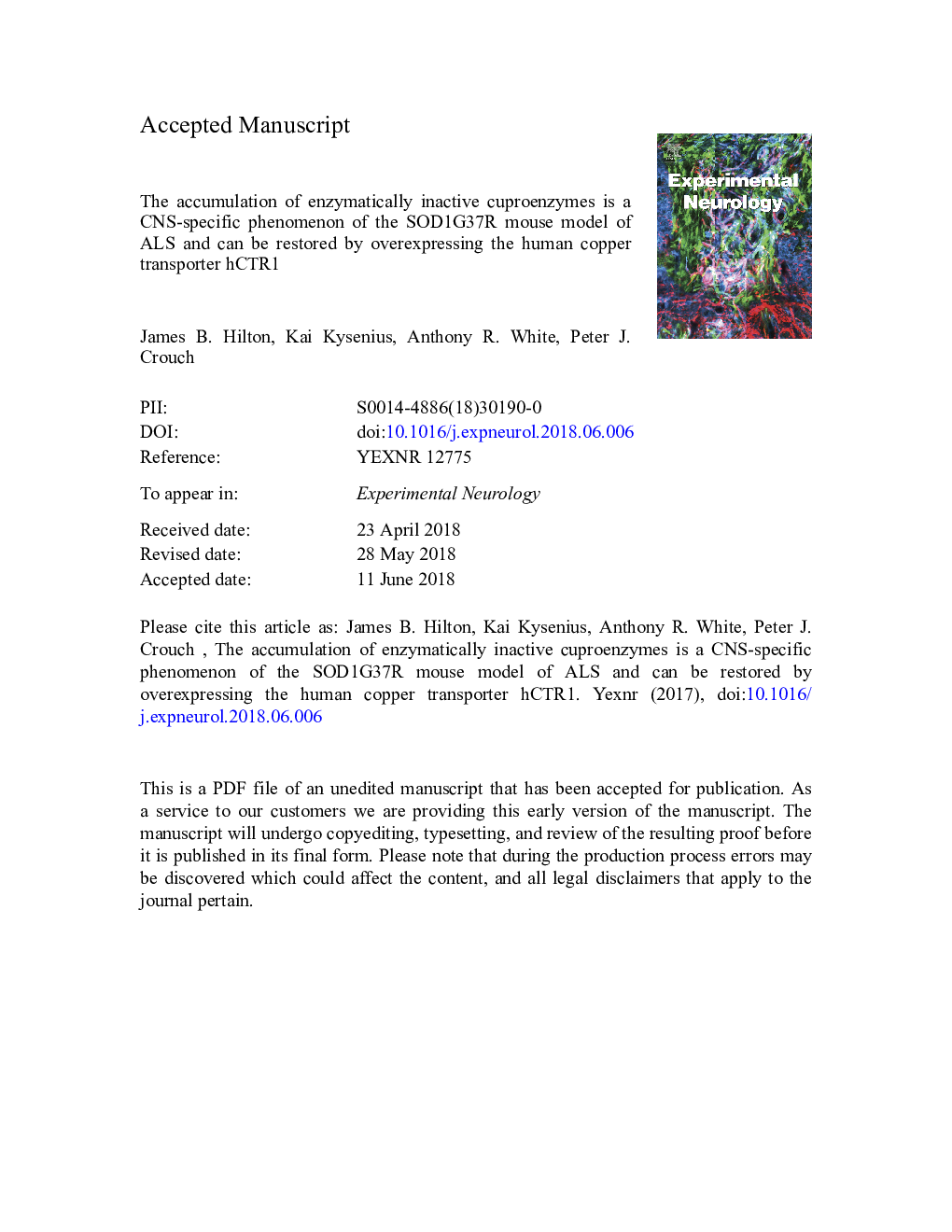| کد مقاله | کد نشریه | سال انتشار | مقاله انگلیسی | نسخه تمام متن |
|---|---|---|---|---|
| 8684565 | 1580130 | 2018 | 28 صفحه PDF | دانلود رایگان |
عنوان انگلیسی مقاله ISI
The accumulation of enzymatically inactive cuproenzymes is a CNS-specific phenomenon of the SOD1G37R mouse model of ALS and can be restored by overexpressing the human copper transporter hCTR1
دانلود مقاله + سفارش ترجمه
دانلود مقاله ISI انگلیسی
رایگان برای ایرانیان
کلمات کلیدی
Human copper transporter 1hCtr1CeruloplasminSOD1CCOCCSamyotrophic lateral sclerosis - اسکلروز جانبی آمیوتروفیکamyotrophic lateral sclerosis (ALS) - اسکلروز جانبی جانبی آمیوتروفیک (ALS)ALS - بیماری اسکلروز جانبی آمیوتروفیکMotor neurone disease - بیماری نورون حرکتیNeurodegeneration - تولید نوروژنیکCNS - دستگاه عصبی مرکزیsuperoxide dismutase 1 - سوپر اکسید دیسموتاز 1Superoxide dismutase 1 (SOD1) - سوپراکسید دیسموتاز 1 (SOD1)cytochrome c oxidase - سیتوکروم سی اکسیدازcentral nervous system - سیستم عصبی مرکزیMouse model - مدل موشCopper - مس
موضوعات مرتبط
علوم زیستی و بیوفناوری
علم عصب شناسی
عصب شناسی
پیش نمایش صفحه اول مقاله

چکیده انگلیسی
Mutations to the copper-dependent enzyme Cu/Zn-superoxide dismutase (SOD1) cause amyotrophic lateral sclerosis (ALS) in humans, and transgenic overexpression of mutant SOD1 represents a robust murine model of the disease. We have previously shown that the copper-containing compound CuII(atsm) phenotypically improves mutant SOD1 mice and delivers copper to copper-deficient SOD1 in the CNS to restore its physiological function. CuII(atsm) is now in clinical trials for the treatment of ALS. In this study, we demonstrate that cuproenzyme dysfunction extends beyond SOD1 in SOD1G37R mice to also affect the endogenous copper-dependent ferroxidase ceruloplasmin. We show that SOD1 and ceruloplasmin both accumulate progressively in the SOD1G37R mouse spinal cord as the animals' ALS-like symptoms progress, yet the biochemical activity of the two cuproenzymes does not increase commensurately, indicating that, as per mutant SOD1, ceruloplasmin accumulates in a copper-deficient form. Consistent with this finding, we show that expression of the human copper transporter 1 (hCTR1) in SOD1G37R mice increases copper levels in the spinal cord and concurrently restores SOD1 and ceruloplasmin activity. Soluble misfolded SOD1, a proposed driver of pathology in this model, is readily detectable in the SOD1G37R mouse spinal cord. However, misfolded SOD1G37R levels do not change in abundance with disease progression and are less abundant than misfolded SOD1 in the spinal cords of age-matched transgenic SOD1WT mice which do not exhibit an evident ALS-like phenotype. Collectively, these outcomes support a copper malfunction phenomenon in mutant SOD1 mouse models of ALS and a copper-related mechanism of action for the therapeutic agent CuII(atsm).
ناشر
Database: Elsevier - ScienceDirect (ساینس دایرکت)
Journal: Experimental Neurology - Volume 307, September 2018, Pages 118-128
Journal: Experimental Neurology - Volume 307, September 2018, Pages 118-128
نویسندگان
James B. Hilton, Kai Kysenius, Anthony R. White, Peter J. Crouch,